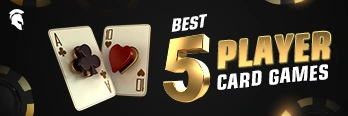Poker is one of the games where you start playing with minimal information (or incomplete information). Don’t you agree? Of course, you do. For the popular variants, you start off with limited hole cards (say 2). It is not possible for you to take your decisions on the basis of just these two cards. You need to start evaluating the various possible combinations that can be formed with these two cards that forms your poker range, along with the community cards that shall show up at different levels.
You also have to take into consideration the possible hands that your opponents might have (their poker hand range) and relate your own holdings to their possible holdings so that you can take better decisions. Remember that the poker players who win the most are the ones who are able to think of all the possible holdings for their opponents and their own possible hands and narrow this range down in further streets. Thus, this range of hands in poker is something which is extremely crucial to understand, analyze and identify if you intend to be a successful poker player!
In this article, let us deep dive into this concept to help you become a better player at poker tournaments and cash games alike!
Overview of Poker Hand Range
Having understood the importance of this, let us try and define a poker range as under:
“It is a combination of hands which a poker player can have on the basis of the game situation and which develops as the hand plays out further.”
As mentioned earlier, highly experienced poker players (who are used to winning) will consider a range of most likely hands of their opponents for a particular situation and eliminate specific single hands from this range as the game (hand) progresses further to other streets. Many beginners to poker make the mistake of considering only a few possible hands (2-3) instead of considering all (or most) of them.
Let us consider a simple example to understand the concept of poker hand ranges.
Say one of your opponents who has a tight game does a ‘raise’ from an early position with his range being premium pocket pairs like AA, KK, QQ, and perhaps even JJ, along with the suited connector AK. If such a player does not place a bet on Ace high flop, then you can eliminate AA as well as AK from your opponent’s range that you are considering.
Online poker platforms like Spartan Poker help you to visualize hand ranges by making use of certain poker hand grids. You can study these grids initially to improve your understanding and mastering ranging your opponent initially.
In doing so, having the following knowledge about possible combinations of different poker hands in a deck of cards will be useful:
- Six combinations each of pocket pairs
- Total 16 combinations each for non-paired hands which comprise of:
- 12 combinations of unsuited hands
- Four combinations of suited hands
Importance of Poker Hand Range
Poker is a game of probability and possibilities, and your betting decisions (or folding decisions) are purely on this basis. You need to be able to calculate the possibilities with regards to hand ranges, and not just take your decision by assuming that the opponent has an AA or KK (if you decide to fold) or 25o or 26o (if you decide to play on). By taking into account all the hand possibilities (entire poker range), you are in the best possible state to take decisions that are best for you at that stage. This helps you to improve your win rate, reduce your losses when opponents have better hands, and increase your profits when opponents have weaker hands.
Understanding Poker Range at Different Streets
The hand range that you determine for your opponents will never stay the same during the entire hand. This range will be quite wide at the preflop stage, but will reduce considerably when the post flop stage occurs. This narrowing down of the range will happen on how the opponent bets for his holdings from preflop range and how the overall hand develops for you. You will have to determine such betting patterns and relate them to the particular opponent’s betting tendencies to make accurate predictions of the poker range at different streets.
Let us check out how to consider the range at various stages below:
1. Preflop Poker Range
When the poker play begins with the preflop round, your opponent can have any of the possible hands. So, his / her range is all possible hands.
Now, if the player does a ‘raise’ from early position, it sends us few hints which if deciphered properly, will help us to narrow down his / her range.
For example, a player doing a ‘raise’ is more likely to have hands like AA, KK, or AK, and very unlikely to have hands like 72o or T3o. If you know more about that player after having observed his / her game quite carefully during previous hands, you will be able to get more precise range for him / her.
If that player is known to have a tight game, then, his ‘raise’ from the early position indicates a very tight range of possible hands, which could be something like below:
AA,KK,…through to TT for pocket pairs
AKs, AQs, AJs, etc. for suited connectors and gappers
AKo, AQo, AJo, etc. for unsuited (offsuit) connectors and gappers
On the other hand, if that player is known to play a loose aggressive game, the range could possibly be much wider and include less premium pocket pairs, suited connectors, unsuited connectors, and gappers.
With this information about the opponent’s hand range, you can determine how your own hand fares against it and how should you play your hand?
While doing the above calculation of your opponent’s hand range at the preflop stage, you also need to consider that enhanced poker training material on various online poker platforms like Spartan Poker has increased the understanding of players for the starting hands to play (at preflop) from different positions of the table. Your position is your power in poker. Generally, this would mean most players starting out with a narrow and tight range from early position and starting out with a much wider range from later positions. The widest of this range will occur when the players are playing from the button position (last position).
2. Post Flop Poker Range (At the Flop/Turn/River)
The determination of the hand range gets more challenging at the post flop stage. Here, no two players are expected to play a specific hand in exactly the same manner with the exact same bet sizes and so on. There are a lot of different scenarios that may turn up with the cards on the table. The more you know about your opponents, the easier it would be for you!
You will have to get answers for following queries in order to be able to effectively use logical reasoning for narrowing down the hand range further:
- Is the opponent bluffing? Does he bluff quite often or very less?
- Is the opponent a passive kind of player who will only bet his strong hands and would mostly check his / her medium hands or poor hands?
- What is the strength of my hand as compared to the range of the opponent and also to all hands in my entire range?
These are just a few sample queries. Getting clarity on more such queries and combining the details of how the opponent is betting, you have to narrow down his range and determine the strength of his hand, in comparison to yours.
Avoid betting against a tight player as he / she is unlikely to call with a hand that is bad than our hand. Also, if you and your opponent both do a ‘check’ at the turn street, it would be logical to ‘check’ at the river since the hand range of the opponent doesn’t change at the river.
Please do remember that this process of hand range analysis is not just restricted to one or two streets. You have to perform this activity and evaluate / re-evaluate the range at every street to enable you to take better decisions at every street.
3. Post-Hand Analysis
Now, isn’t it difficult to do so much of poker range analysis at every street? And isn’t it time consuming? Of course, it is. There is no denial about that. But, you will be able to do it quickly as you practise more and consume more hand range related training content. The idea is for you to keep getting better at it!
Now, your analysis is not limited to just during gameplay. You can try out doing some post hand analysis. For this purpose, you will have to be extremely vigilant as many players on the table will provide you with these opportunities at the time of showdown or by folding their cards and revealing them just to show off their set. Such information will help you to correctly profile the other players on the table and profitably deal with them in the future hands.
You may also do effective post hand analysis using the training material or study session material. You can review your own gameplay and even that of your opponents. You can identify the mistakes you did and note them down to be able to eliminate them in future.
Different Ways / Methods to Tackle Hand Ranges of Opponents
During gameplay, when you make predictions about your opponent’s hand range and the opponent reacts in a certain way in terms of ‘bets’ or ‘raises’, you need to have certain methods in place to counter the play of your opponent. Few of these methods are discussed below:
- Big Blind Defence
When you are placing the big blind bet at pre-flop, you must attempt to defend a big portion of your hand range so as to not get exploited by opponents by opting to fold your cards more often than you should have. If you are an experienced poker player with strong abilities to perform at the post flop stage, you can opt to play a wider defending range with your blinds position. On the other hand, you are a newbie to poker and hand ranges, you need to tighten your blind range so as to prevent tricky situations at the post flop stage.
- Minimum Defence Frequency (MDF)
You do not want to be the player who simply folds up on seeing the opponent betting. You may want to have a tight game, but, that does not mean you should resort to excessive folding. This is because if you come across as a player who folds quite a lot, it will give your opponents the opportunity to bluff you more often. To counter this, you have to decide your MDF (Minimum Defence Frequency) which is the minimal amount that you should ‘call’ or ‘raise’ the bet of your opponent (to avoid being exploited as mentioned above).
This MDF is based on your range of potential hand combinations as well as the opponent’s bet size. It will showcase you how frequently and what quantity of your range you must defend.
The corresponding formula is as under:
Pot size / [Pot size + bet size]
You have to work out MDF calculations in your post game hand reviews and not during gameplay (when it is not possible to do so). This off-table study will help you to have a defined strategy against strong opponents about whom you do not have much information.
You should not use MDF while playing against weaker opponents (who can be easily exploited by your aggressive play). Also, you should refrain from using MDF against opponents who do not have bluffs in their range. You must not use MDF while being out of position against flop or turn cbets as you would not be able to realize your full equity.
- Identifying Weaker Players and Weaker Play Tendencies
You must find out who the weaker players are, and going by their plays in last couple of hands you would easily be able to identify them. You can counter weaker players and their tendencies with ease. Also, identify players who are predictable. For example, you wouldn’t want to raise / re-raise against an extremely tight player who raises or bets only on AA,KK,QQ or AK.
Balancing Your Own Hand Range in Poker
So far we have discussed about mastering ranging your opponent. While this is necessary, you must also be analyzing your own hand range and come up with various decent ranges for the cards you hold at different stages. You need to try and build some clarity and decisiveness about your calling range, raising range, as well as your re-raising range (3bet range).
It is difficult to achieve this considering the different factors involved like your position, your opponent’s position, the number of players on the poker table, and so on.
The key to this is having a balanced hand range. While you are determining the opponent’s hand ranges, even they are analyzing your hand range. You do want to make it easy for them to narrow down your range at any street. And you surely do not want them to narrow it down to just 1, 2, or 3 hands.
Consider you are playing a game with less number of players. You get two aces (AA) at an early position and you limp. Now, you have many raises before you and this makes you choose to go ‘all-in’ with an opponent who shows AK, as you win the pot for that hand. Do you think you had a profitable play?
Well, it was profitable for that round, but it revealed a lot to the opponents. So, next time you limp, your opponents would know what’s in store and will be careful before doing a ‘raise’. This happened because the opponents were able to narrow down your range to just one hand or may be two hands – AA (after watching you win that game). Your aim should be to avoid your opponents from playing in the same manner that they would have probably played had they known your cards.
It is critical have various types of hands in your range and build it properly. And at least one of this range should most likely hit the flop. This is easier said than done!
How can you develop a raising hand range?
Let’s consider that you find it difficult to build a range (especially a raising range) from early position against players who are tight (but not very tight). For such a scenario, you have to ensure that your hands are relatively strong as you have the position disadvantage. But, you must not select your hands only on the basis of their strength. You need to have a good balanced range that makes it difficult and confusing for your opponents to tackle it perfectly.
As your position moves towards the button (the last position), you need to add more hands to your range as you start gaining the position advantage and also the number of players whose turn appears after you keeps getting smaller. So, you can explore playing with less strong hands as well.
A similar approach will have to be used even for re-raises. You need to find a balance between premium and not-so-good hands against which you can ‘re-raise’. It is simple – if you don’t find the balance for your hand range, you will get figured out by your opponents pretty soon and you will not be able to earn more even from your strongest hands.
When it comes to draws, you have to remember that not all of them are created equal. So, if you happen to go for semi-bluff with all of these, you are likely to be figured out easily with too many bluffs in your hand range. Other players can start to tackle such a strategy effectively with check-raises.
So, how many bluffs in your range against the value hands count is a good number? Well, there is no fixed rule for the same. But, the ratio of bluffs / semi-bluffs to value hands should be more on the flop (almost 2:1), then, it should reduce at the turn (almost equal for both) and the ratio should reduce the most at the river (almost 1:2 for bluff to value hands).
As a standard approach, you can aim to do the following with draws:
- Check or call for the strongest draws
- Bet or raise for the weakest draws
Are you a good poker player? If yes, do you want to remain just a good player or become a great player? If you wish to transition from a good poker player to a very good / great poker player, you will have to start building your own hand ranges and identify clear ways by which you can progress with them during post flop stages whilst maintaining a balanced range. This is in addition to analyzing the ranges of your opponents – which most good poker players already do!
The Verdict
To summarize, hand ranges should be an integral part of your poker strategy if you wish to become a professional poker player. You need to work on building your own poker range as well as analyzing the details of hand ranges for your opponents. The aim should be to narrow down the opponent’s ranges as you progress further the streets, and do not allow your opponents to significantly narrow down your own range. By playing more real money poker games online on platforms like Spartan Poker, you will improve your ability to accurately determine your opponent’s ranges. So, do not delay this further and download the Spartan Poker app now to start practising your hand ranges during actual game play.
Also, you need to start utilising the study material and trainings to become a pro at accurately ranging your opponents, along with doing several off-table reviews of your hands till you are confident of using hand ranges to win big in poker!

















